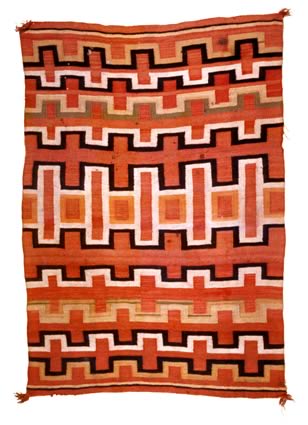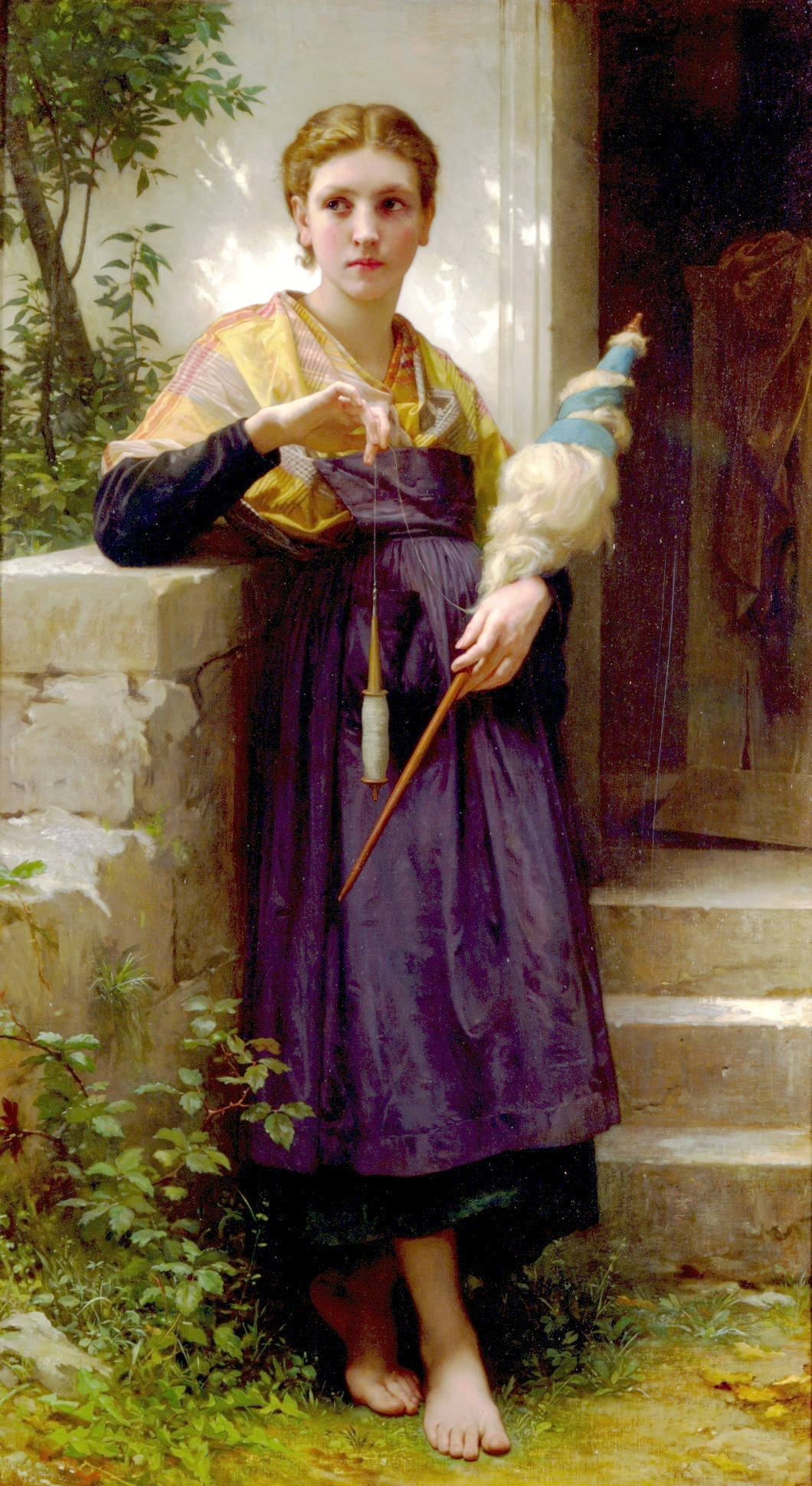|
Daisy Taugelchee
Daisy Taugelchee ( 1909September 8, 1990) was a Navajo weaver. The Denver Art Museum declared Taugelchee is "widely considered the most talented Navajo weaver and spinner who ever lived". In 2004 one of her rugs was featured on a United States Postal Service stamp. Biography Various dates are given for Taugelchee's birth, including 1909, circa 1910, 1911, and circa 1920. In her obituary, her birth date was given as April 4, 1909. She was born on the Navajo Nation reservation in Arizona. Taugelchee's paternal grandmother was an accomplished weaver known as Sagebrush Hill Woman, herself one of the best of the early Toadlena/Two Grey Hills weavers. Taugelchee's sister was also a well-regarded weaver. Taugelchee's mother died in childbirth when she was six years old, and her father died when she was eleven. In her youth, Daisy was known as Little Man's Daughter (Hastiin Yazhi Bitsi) and was given the name Daisy Marion Yazzie when she went to school. She attended Albuquerque Indian S ... [...More Info...] [...Related Items...] OR: [Wikipedia] [Google] [Baidu] |
Navajo Nation
The Navajo Nation ( nv, Naabeehó Bináhásdzo), also known as Navajoland, is a Native American reservation in the United States. It occupies portions of northeastern Arizona, northwestern New Mexico, and southeastern Utah; at roughly , the Navajo Nation is the largest land area held by a Native American tribe in the U.S., exceeding ten U.S. states. In 2010, the reservation was home to 173,667 out of 332,129 Navajo tribal members; the remaining 158,462 tribal members lived outside the reservation, in urban areas (26 percent), border towns (10 percent), and elsewhere in the U.S. (17 percent). The seat of government is located in Window Rock, Arizona. The United States gained ownership of this territory in 1848 after acquiring it in the Mexican-American War. The reservation was within New Mexico Territory and straddled what became the Arizona-New Mexico border in 1912, when the states were admitted to the union. Unlike many reservations, it has expanded several times since ... [...More Info...] [...Related Items...] OR: [Wikipedia] [Google] [Baidu] |
Farmington, New Mexico
Farmington is a city in San Juan County in the U.S. state of New Mexico. As of the 2020 census the city had a total population of 46,624 people. Farmington (and surrounding San Juan County) makes up one of the four Metropolitan Statistical Areas (MSAs) in New Mexico. Farmington is located at the junction of the San Juan River, the Animas River, and the La Plata River, and is located on the Colorado Plateau. Farmington is the largest city of San Juan County, one of the geographically largest counties in the United States covering . Farmington serves as the commercial hub for most of northwestern New Mexico and the Four Corners region of four states. Farmington lies at or near the junction of several important highways: U.S. Highway 64, New Mexico Highway 170, New Mexico Highway 371, and New Mexico Highway 516. It is on the Trails of the Ancients Byway, one of the designated New Mexico Scenic Byways. [...More Info...] [...Related Items...] OR: [Wikipedia] [Google] [Baidu] |
Navajo Weaving
Navajo rugs and blankets ( nv, ) are textiles produced by Navajo people of the Four Corners area of the United States. Navajo textiles are highly regarded and have been sought after as trade items for over 150 years. Commercial production of handwoven blankets and rugs has been an important element of the Navajo economy. As one expert expresses it, "Classic Navajo serapes at their finest equal the delicacy and sophistication of any pre-mechanical loom-woven textile in the world." Navajo textiles were originally utilitarian blankets for use as cloaks, dresses, saddle blankets, and similar purposes. Toward the end of the 19th century, weavers began to make rugs for tourism and export. Typical Navajo textiles have strong geometric patterns. They are a flat tapestry-woven textile produced in a fashion similar to kilims of Eastern Europe and Western Asia, but with some notable differences. In Navajo weaving, the slit weave technique common in kilims is not used, and the warp is on ... [...More Info...] [...Related Items...] OR: [Wikipedia] [Google] [Baidu] |
Denver Art Museum
The Denver Art Museum (DAM) is an art museum located in the Civic Center of Denver, Colorado. With encyclopedic collections of more than 70,000 diverse works from across the centuries and world, the DAM is one of the largest art museums between the West Coast and Chicago. It is known for its collection of American Indian art, as well as The Petrie Institute of Western American Art, which oversees the museum's Western art collection. and its other collections of more than 70,000 diverse works from across the centuries and world. The museum's iconic Martin Building (formerly known as the North Building) was designed by famed Italian architect Gio Ponti in 1971. In 2018, the museum began a transformational $150 million renovation project to unify the campus and revitalize Ponti's original structure, including the creation of new exhibition spaces, two new dining options, and a new welcome center. History 1893–1923 The museum's origins can be traced back to the founding of the ... [...More Info...] [...Related Items...] OR: [Wikipedia] [Google] [Baidu] |
United States Postal Service
The United States Postal Service (USPS), also known as the Post Office, U.S. Mail, or Postal Service, is an independent agency of the executive branch of the United States federal government responsible for providing postal service in the U.S., including its insular areas and associated states. It is one of the few government agencies explicitly authorized by the U.S. Constitution. The USPS, as of 2021, has 516,636 career employees and 136,531 non-career employees. The USPS traces its roots to 1775 during the Second Continental Congress, when Benjamin Franklin was appointed the first postmaster general; he also served a similar position for the colonies of the Kingdom of Great Britain. The Post Office Department was created in 1792 with the passage of the Postal Service Act. It was elevated to a cabinet-level department in 1872, and was transformed by the Postal Reorganization Act of 1970 into the U.S. Postal Service as an independent agency. Since the early 1980s, m ... [...More Info...] [...Related Items...] OR: [Wikipedia] [Google] [Baidu] |
Albuquerque Indian School
Albuquerque Indian School (AIS) was a Native American boarding school in Albuquerque, New Mexico, which operated from 1881 to 1981. It was one of the oldest and largest off-reservation boarding schools in the United States. For most of its history it was run by the Bureau of Indian Affairs (BIA). Like other government boarding schools, AIS was modeled after the Carlisle Indian Industrial School, using strict military-style discipline to strip students of their native identity and assimilate them into white American culture. The curriculum focused on literacy and vocational skills, with field work components on farms or railroads for boys and as domestic help for girls. In the 1930s, as the philosophy around Indian education changed, the school shifted away from the military approach and offered more training in traditional crafts like pottery, weaving, and silversmithing. In 1977, administration of the school was taken over by the All Indian Pueblo Council, a coalition of the 2 ... [...More Info...] [...Related Items...] OR: [Wikipedia] [Google] [Baidu] |
Phoenix Indian School
The Phoenix Indian School, or Phoenix Indian High School in its later years, was a Bureau of Indian Affairs-operated school in Encanto Village, in the heart of Phoenix, Arizona. It served lower grades also from 1891 to 1935, and then served as a high school thereafter. It opened in 1891 and closed in 1990 on the orders of the federal government. During its existence, it was the only non-reservation BIA school in Arizona. The Phoenix Indian School Historic District, a portion of the campus that contains some of the most historic buildings, became part of the National Register of Historic Places in 2001. History 1891–1931: Phoenix Indian School 19th century After a year-long search for a school site, the Indian School opened in 1891 on of land. Up until 1931, the federal "assimilation" policy that sought to regimentalize and culturally assimilate Native American students was in place. Physical growth was the major theme in the 1890s as the school opened. Growth in studen ... [...More Info...] [...Related Items...] OR: [Wikipedia] [Google] [Baidu] |
Hand Spinning
Spinning is an ancient textile arts, textile art in which fibre crop, plant, animal fibre, animal or synthetic fibre, synthetic fibres are drawn out and twisted together to form yarn. For thousands of years, fibre was spun by hand using simple tools, the Spindle (textiles), spindle and distaff. It was only with the invention of the spinning wheel in the Islamic world circa 1030, and its subsequent introduction to China, India and Europe in the High Middle Ages, that the output of individual spinners dramatically increased. Mass production later arose in the 18th century with the beginnings of the Industrial Revolution. Hand-spinning remains a popular handicraft. Characteristics of spun yarn vary according to the material used, fibre length and alignment, quantity of fibre used, and degree of twist. History The origins of spinning fibre to make string or yarn are lost in time, but archaeology, archaeological evidence in the form of representation of string skirts has been date ... [...More Info...] [...Related Items...] OR: [Wikipedia] [Google] [Baidu] |
1990 Deaths
Year 199 ( CXCIX) was a common year starting on Monday (link will display the full calendar) of the Julian calendar. At the time, it was sometimes known as year 952 '' Ab urbe condita''. The denomination 199 for this year has been used since the early medieval period, when the Anno Domini calendar era became the prevalent method in Europe for naming years. Events By place Roman Empire * Mesopotamia is partitioned into two Roman provinces divided by the Euphrates, Mesopotamia and Osroene. * Emperor Septimius Severus lays siege to the city-state Hatra in Central-Mesopotamia, but fails to capture the city despite breaching the walls. * Two new legions, I Parthica and III Parthica, are formed as a permanent garrison. China * Battle of Yijing: Chinese warlord Yuan Shao defeats Gongsun Zan. Korea * Geodeung succeeds Suro of Geumgwan Gaya, as king of the Korean kingdom of Gaya (traditional date). By topic Religion * Pope Zephyrinus succeeds Pope Victor I, as ... [...More Info...] [...Related Items...] OR: [Wikipedia] [Google] [Baidu] |







